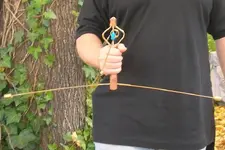teleprospector
Silver Member
- Joined
- Jul 8, 2007
- Messages
- 3,974
- Reaction score
- 4,246
- Golden Thread
- 0
- Location
- The Motor City
- 🏆 Honorable Mentions:
- 25
- Detector(s) used
- Extended Sensory Perception, L-rod, Y-rod, pendulum, angle rods, wand.
White's MXT, Garrett Ultra GTA 500, AT Gold, SCUBA Detector Pro Headhunter, Tesoro Sidewinder, Stingray, 2 box-TF900, Fisher TW-6
- Primary Interest:
- All Treasure Hunting
- #1
Thread Owner
As a user, collector, designer and builder of electronic and non electronic locating instruments I finally ordered the RLR (Revelation Locator Rod). The package arrived intact and contained 4 pieces to the locator; the antennae, 2 stabilizer rods and the handle. The unit's handle contains an amplifier/power load. Assembling the unit was easy, just attach the antennae to the blue mechanism and slide the stabilizers onto the stems at the bottom of the handle. The weight of the unit was not distracting to me.
I found the unit's best sensitivity and balance when the antennae is attached just in front of the small circle twist on the antennae. I used the back coil of the antennae as a rear witness/sample chamber by simply inserting a silver dime or a folded up U.S. dollar bill between the coil windings. You could always tape or paper clip your sample to the coil also.
Design with the beginner in mind:
Most people are uncomfortable using a one hand locator beacause the feel better "balanced" holding onto two. Not so with this unit. It remained very stable with the stabilizers on as I swept it in a circle. Once you become comfortable then you can always take the stabilizers off.
Please keep in mind that I tested this unit as a DIRECTIONAL LOCATOR using the sweep method. This means that I baited the unit and let it work to the test targets without any mind influence. The sweep method is simply holding the unit in the proper position, with the antennae pointed forward and watching for a lock response while turning your upper body slowly in a circle for as far as you can without moving your feet. Once you get a response go past it a bit then sweep back in the other direction to lock it in.
The tests below were "AIR TESTS". Some users during practice may find these range tests shorter/further than what I recorded, as individual body response using the unit will vary.
Bait: 1 1964 silver dime
Range results:
1 silver dime 45'
1 silver quarter 65'
1 silver half 90'
1 silver dollar 130'
Pint size glass jar of mixed silver coins 1,200'
Bait: 1 U.S. dollar bill
Range results:
1/4" stack of mixed bills in glass jar 200'
As a DOWSING locator:
I found the RLR very smooth, lightweight and sensitive while using it for map/photo work.
Contact Mike (Mont) with any further questions.
Jon
I found the unit's best sensitivity and balance when the antennae is attached just in front of the small circle twist on the antennae. I used the back coil of the antennae as a rear witness/sample chamber by simply inserting a silver dime or a folded up U.S. dollar bill between the coil windings. You could always tape or paper clip your sample to the coil also.
Design with the beginner in mind:
Most people are uncomfortable using a one hand locator beacause the feel better "balanced" holding onto two. Not so with this unit. It remained very stable with the stabilizers on as I swept it in a circle. Once you become comfortable then you can always take the stabilizers off.
Please keep in mind that I tested this unit as a DIRECTIONAL LOCATOR using the sweep method. This means that I baited the unit and let it work to the test targets without any mind influence. The sweep method is simply holding the unit in the proper position, with the antennae pointed forward and watching for a lock response while turning your upper body slowly in a circle for as far as you can without moving your feet. Once you get a response go past it a bit then sweep back in the other direction to lock it in.
The tests below were "AIR TESTS". Some users during practice may find these range tests shorter/further than what I recorded, as individual body response using the unit will vary.
Bait: 1 1964 silver dime
Range results:
1 silver dime 45'
1 silver quarter 65'
1 silver half 90'
1 silver dollar 130'
Pint size glass jar of mixed silver coins 1,200'
Bait: 1 U.S. dollar bill
Range results:
1/4" stack of mixed bills in glass jar 200'
As a DOWSING locator:
I found the RLR very smooth, lightweight and sensitive while using it for map/photo work.
Contact Mike (Mont) with any further questions.
Jon









